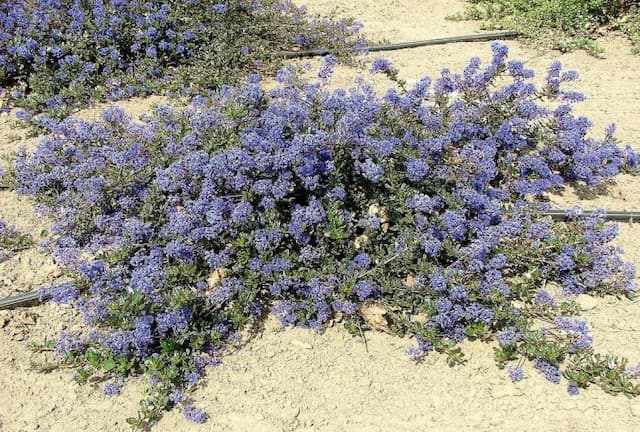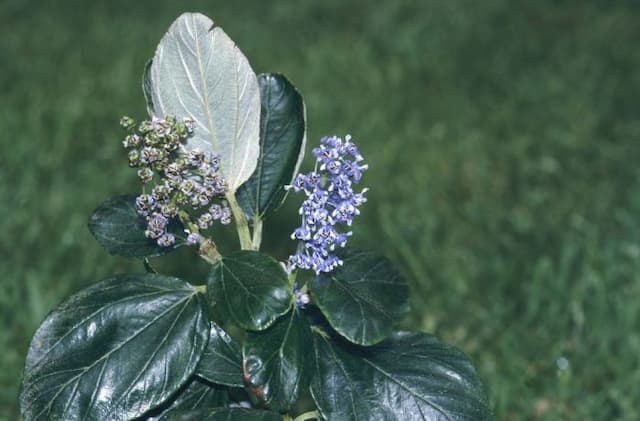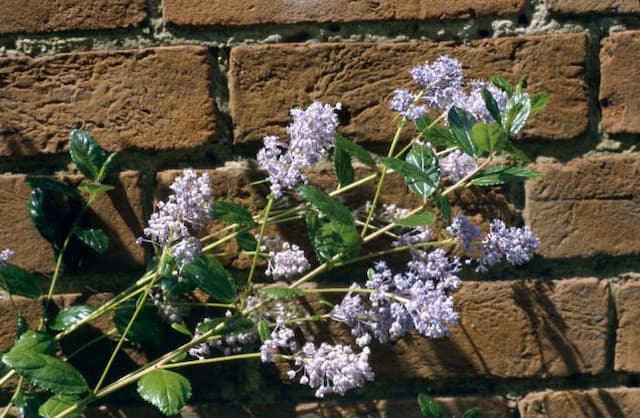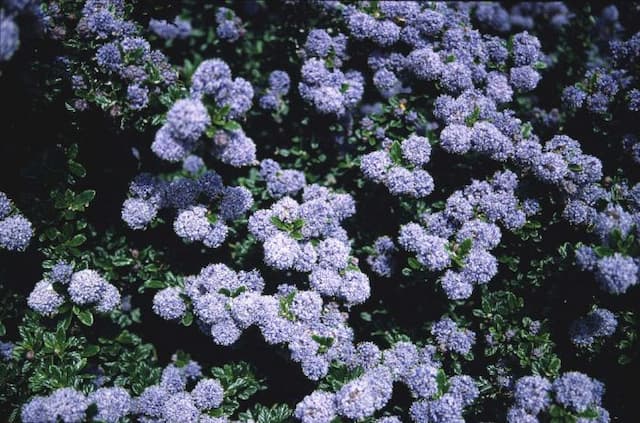Blue Blossom Ceanothus × delileanus 'Gloire de Versailles'

ABOUT
The plant known as 'Gloire de Versailles' boasts clusters of soft blue flowers that bloom profusely, creating a showy display. These blossoms appear throughout the summer into the fall, attracting pollinators with their nectar-rich presence. The leaves of 'Gloire de Versailles' have an oval shape and a bright green hue, which provides a luscious backdrop to the delicate flowers. As the seasons change, the foliage may turn to shades of yellow, adding to the plant's ornamental value. The overall form of this plant is rounded, with arching branches that contribute to its graceful and inviting appearance in the landscape.
About this plant
 Names
NamesFamily
Rhamnaceae
Synonyms
Gloire de Versailles, Blue Blossom, California Lilac, Wild Lilac
Common names
Ceanothus × delileanus 'Gloire de Versailles'
 Toxicity
ToxicityTo humans
The California lilac, specifically Ceanothus × delileanus 'Gloire de Versailles', is not generally considered toxic to humans. It does not usually pose any significant health risks if touched or ingested in small quantities. However, as with many plants, individual allergies or sensitivities could cause mild irritation or allergic reactions in some people.
To pets
California lilac is not known to be toxic to pets. It is not listed among the common plants that pose a risk to dogs, cats, or other domestic animals. That being said, ingestion of large amounts of plant material may lead to gastrointestinal upset in some animals due to the plant's fiber content and non-digestible nature. Symptoms of a gastrointestinal upset could include vomiting and diarrhea, although these would more likely arise from the animal's body rejecting a non-standard food rather than a specific toxin present in the plant.
 Characteristics
CharacteristicsLife cycle
Perennials
Foliage type
Deciduous
Color of leaves
Green
Flower color
Blue
Height
6 feet (1.8 meters)
Spread
8 feet (2.4 meters)
Plant type
Shrub
Hardiness zones
5
Native area
Hybrid
Benefits
 General Benefits
General Benefits- Ornamental Appeal: 'Gloire de Versailles' adds aesthetic value to gardens with its beautiful blue flowers and lush green foliage.
- Attracts Pollinators: The blooms are attractive to bees, butterflies, and other pollinating insects, beneficial for the garden ecosystem.
- Drought Tolerance: Once established, it is quite drought-tolerant, making it suitable for xeriscaping and water-wise gardens.
- Low Maintenance: Requires minimal pruning and care once established, making it an easy plant to maintain for busy gardeners.
- Fast Growth: It grows relatively quickly, which allows gardeners to enjoy its mature form sooner than many other shrubs.
- Long Blooming Season: It offers a long season of bloom, typically from mid-summer to fall, providing prolonged color in the garden.
- Versatility: Can be used in various landscaping applications, including as a hedge, specimen plant, or in a mixed shrub border.
- Wildlife Shelter: Provides shelter and nesting sites for birds and other wildlife, enhancing biodiversity in the garden.
- Soil Adaptability: It's adaptable to a variety of soil types, though it prefers well-draining soil.
- Seasonal Interest: Offers year-round interest with its summer flowers, autumn berries, and evergreen foliage in mild climates.
 Medical Properties
Medical PropertiesThis plant is not used for medical purposes.
 Air-purifying Qualities
Air-purifying QualitiesThis plant is not specifically known for air purifying qualities.
 Other Uses
Other Uses- Ceanothus 'Gloire de Versailles', commonly known as California lilac, can be used for natural dyeing; its flowers sometimes yield a blue or greenish color, adding a unique touch to fabrics.
- Its dense foliage can be maintained in a compact form, making it an ideal candidate for topiary or shaped hedges in garden design.
- With its woody stems, California lilac can be used to create small garden structures like trellises when pruned appropriately.
- California lilac can be planted to help prevent soil erosion on slopes due to its extensive root system that holds the soil firmly.
- They are suitable for bonsai cultivation for enthusiasts who enjoy miniaturized trees.
- The dried flowers of California lilac can be incorporated into potpourri blends for their soft color and mild fragrance.
- Bees are highly attracted to California lilac, making it a beneficial plant for beekeepers and those looking to support pollinator populations.
- The bush can act as a privacy screen in gardens due to its potential for lush and dense growth.
- Suitable for coastal gardens, California lilac can withstand salt spray, making it an unconventional choice for beachside landscapes.
- When planted en masse, California lilac can provide a habitat for beneficial insects, promoting a healthy and balanced ecosystem in the garden.
Interesting Facts
 Feng Shui
Feng ShuiThe California lilac is not used in Feng Shui practice.
 Zodiac Sign Compitability
Zodiac Sign CompitabilityThe California lilac is not used in astrology practice.
 Plant Symbolism
Plant Symbolism- Hope and Aspiration: The Ceanothus, commonly known as the California Lilac, often symbolizes hope and aspiration due to its vigorous growth habit and the profusion of beautiful blooms it produces.
- Endurance: As a plant that can thrive in difficult conditions, California Lilac is sometimes associated with endurance and the ability to withstand challenges.
- Patriotism: In some contexts, especially within the United States, the California Lilac's blue flowers can evoke a sense of patriotism, as blue is one of the colors of the American flag.
- Peace and Tranquility: The calming shade of blue of its flowers is often associated with peace and tranquility, reflecting the serene environments where it is typically found.
 Water
WaterThe California Lilac 'Gloire de Versailles' prefers evenly moist soil, especially during its first growing season to establish a deep, extensive root system. After established, reduce frequency, but continue to provide regular watering. Water the plant deeply once a week, applying approximately 1 to 1.5 gallons of water around the base of the plant, ensuring that the soil is soaked but not waterlogged. During hot and dry periods, you may need to water twice a week. Always check the top inch of soil for dryness before watering to avoid over-watering.
 Light
LightCalifornia Lilac 'Gloire de Versailles' thrives best in full sun to partial shade. It should receive at least six hours of direct sunlight daily, though it can tolerate some light afternoon shade. A spot that offers morning sunlight with some protection from the intense heat of the late afternoon will be ideal for this plant.
 Temperature
TemperatureThe California Lilac 'Gloire de Versailles' prefers a mild to warm climate and can tolerate temperatures as low as 10°F but has an optimal temperature range of 60°F to 75°F. It can survive periods of cold down to about 10°F; however, it thrives best and flowers most abundantly when temperatures remain above freezing.
 Pruning
PruningPrune the California Lilac 'Gloire de Versailles' to maintain its shape and encourage bushier growth. Pruning should be done after flowering, typically in late summer or early fall. Remove about one-third of the oldest stems to ground level every few years to rejuvenate the plant and encourage new growth. Light shaping can be done as needed, but avoid heavy pruning which can reduce flowering.
 Cleaning
CleaningAs needed
 Soil
SoilThe California lilac prefers a well-draining, fertile soil mix with a pH range between 6.0 and 8.0. Amend the soil with organic matter like compost or well-rotted manure and provide adequate drainage by adding sand or perlite to prevent waterlogging.
 Repotting
RepottingCalifornia lilac, being a large shrub, is not typically repotted. It's usually planted directly into the ground where it has space to grow. Container-grown plants may need repotting every 2-3 years to refresh the soil.
 Humidity & Misting
Humidity & MistingCalifornia lilac thrives in moderate to low humidity conditions typical of its natural habitat. It does well in the average humidity found outdoors in its growing zones and does not require any special humidity adjustments.
 Suitable locations
Suitable locationsIndoor
Place in full light, water moderately, and ensure good air circulation.
Outdoor
Plant in full sun, ensure good drainage, prune as necessary.
Hardiness zone
7-10 USDA
 Life cycle
Life cycleCeanothus × delileanus 'Gloire de Versailles', commonly known as California lilac, begins its life as a seed, typically germinating after exposure to warm temperatures following a chilling period. Seedlings develop into juvenile plants with a growing root system and foliage over the first season. As the plant matures, it enters the vegetative stage, where it grows rapidly, forming a woody structure with clusters of leaves. The reproductive stage follows, where California lilac showcases profuse blue to violet flower clusters in the summer, attracting pollinators like bees and butterflies. After pollination, the plant produces fruit in the form of dry capsules which release seeds when mature. The plant continues this cycle annually, with a lifespan that can extend several years, during which time it can also spread by layering or cuttings.
 Propogation
PropogationPropogation time
Summer
The California lilac 'Gloire de Versailles' is best propagated through semi-hardwood cuttings. The ideal time for this is in late summer, after the plant has flowered and the new growth has begun to mature and harden slightly. To propagate from cuttings, select healthy, non-flowering shoots and cut a length of about 6 to 8 inches (15 to 20 cm), ensuring each cutting has at least a couple of leaf nodes. Strip the leaves from the lower half of the cutting, dip the cut end into rooting hormone powder to encourage root development, and insert it into a well-draining potting mix. Cover the pot with a plastic bag to maintain humidity, and place it in a warm, brightly lit area out of direct sunlight until roots develop, which can take several weeks. After rooting, the new plants can be gradually acclimatized to outside conditions before planting out in spring.









